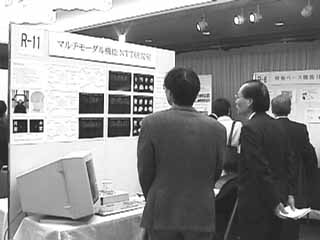Multi-Modal Functions Sanyo Laboratory
http://www.rwcp.or.jp/activities/achievements/MM/sanyo/index-j.html

2)The method then determines the tracking points and detects corresponding points from frame to frame using local edge features in the image sequences such as a tangent vector at each point in the first frame and a change of intensity along this vector.
3)Next, parameters of the hand motion are calculated using the coordinates of the corresponding point pairs in each image under the constraint of planar surface motion. Finally, the 3-D model of the object can be manipulated on a PC by changing its position and orientation with calculated motion parameters.
Multi-Modal Functions NTT Laboratory
http://www.brl.ntt.co.jp/cs/rwcp/index-j.html

According to the neuropsychological studies, the occipitotemporal area is involved in reading kanji characters while the occipitoparietal area is activated in reading kana characters. Our results, however, showed that both areas were activated in reading kanji characters.
Information-Based Mitsubishi
http://www.rwcp.or.jp/activities/achievements/IB/mitsubishi/achieve_j.html

Conventional retrieval systems only allow us to retrieve a list of documents (typically many in number) that include the specified keywords. However, the present system allows us to directly retrieve the sentence that is a response to the query and the context in which it appears, in an interactive manner.
If the object to be retrieved is plain text, the implementation of semantic information retrieval becomes very difficult. Semantic information retrieval, however, becomes possible without waiting for the solution of various subjects (ellopsis, anaphora, disambiguation, etc.) in natural language processing technology if we attach tags to the text of the object to be retrieved beforehand. Although the principle of the present system is still being verified, we are planning to complete a prototype in two years through further research and development.